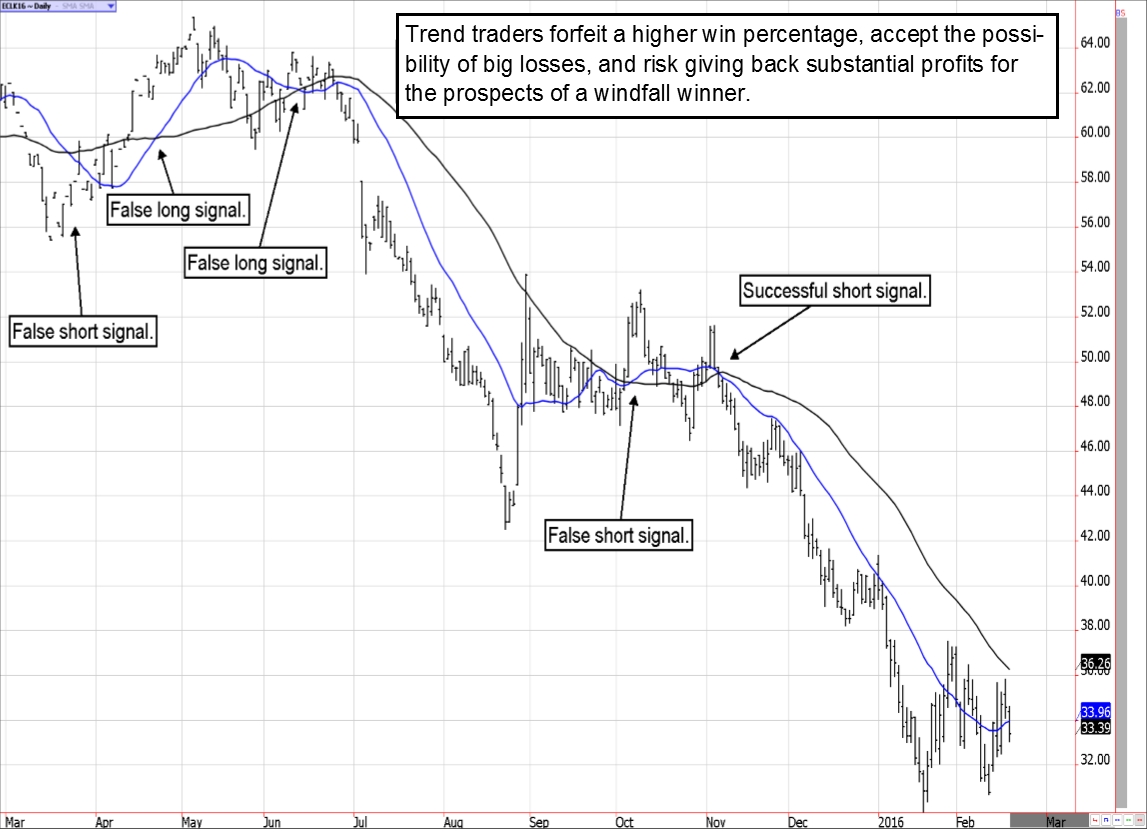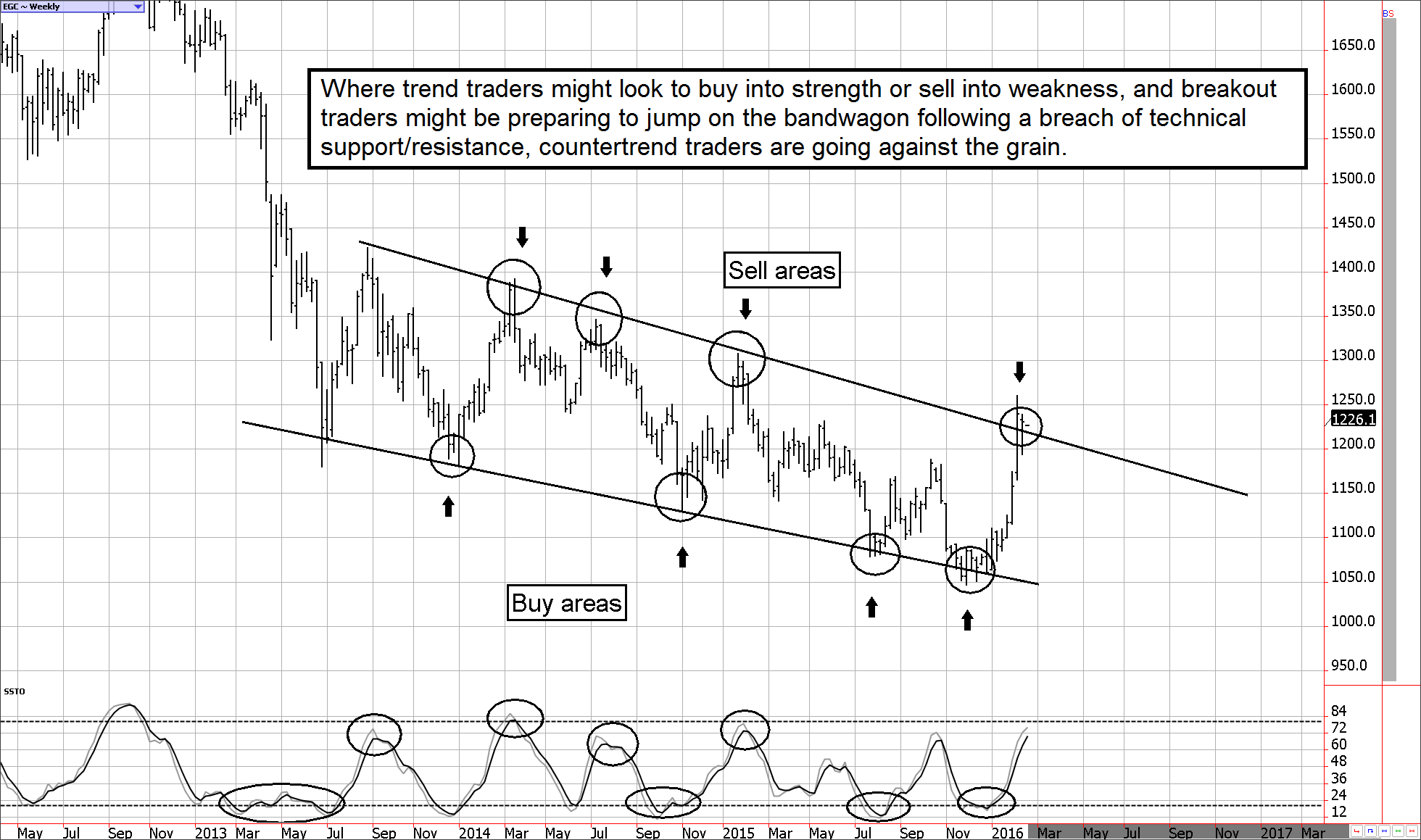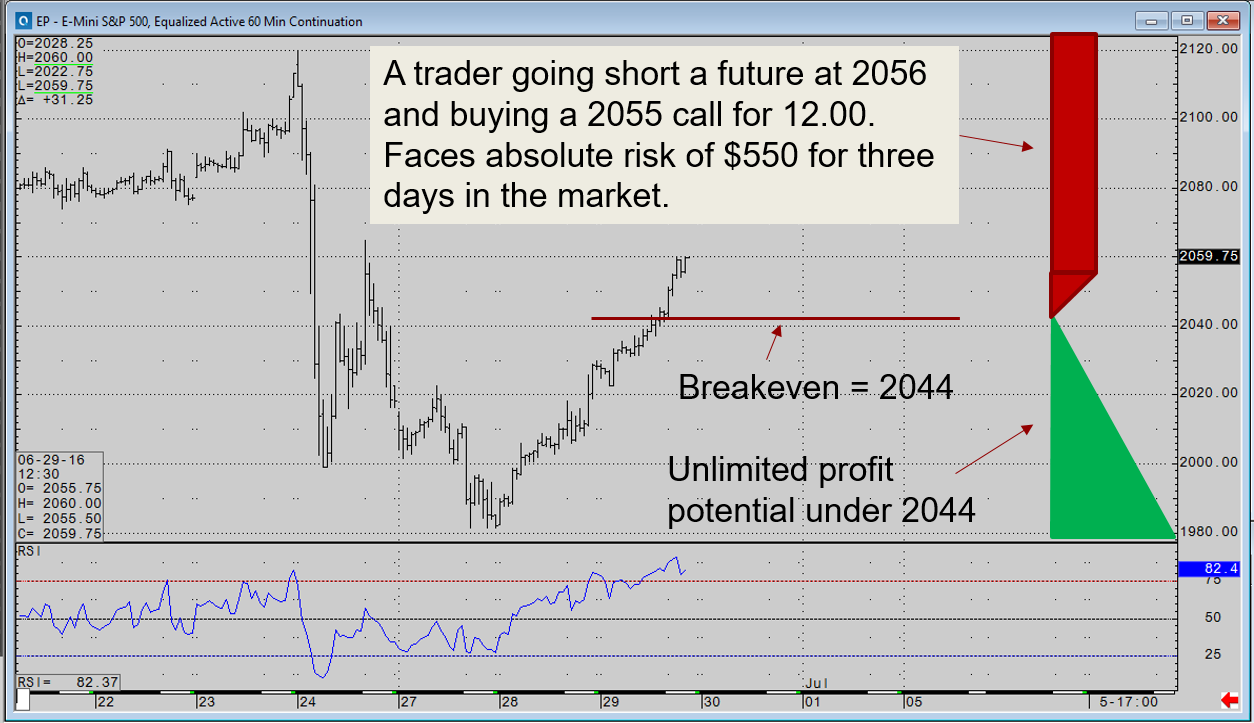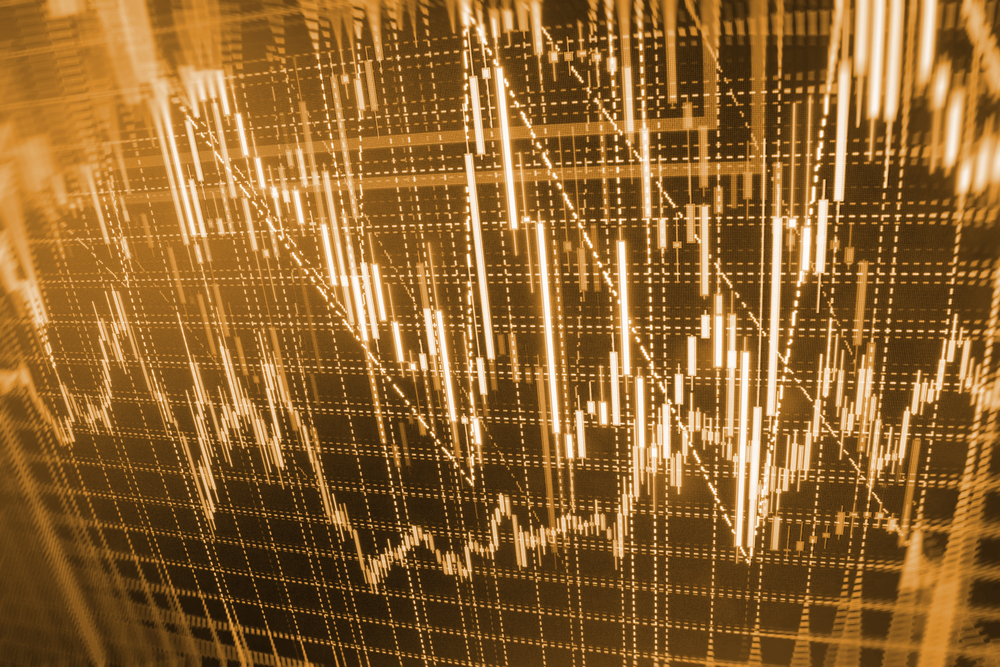Conventional wisdom suggests that “the trend is your friend” but in my opinion, there is evidence to suggest although this is true in some cases, it is a false statement a majority of the time. In fact, on average a trend trading strategy involves higher risks per trade and a lower percentage of winners than most trading strategies. Only those with extremely deep pockets, nerves of steel, and intense discipline are capable of trend trading profitably. Perhaps a better alternative for the average retail speculator is swing trading.
Figure 1 depicts a common problem for trend traders; a high number of false signals can lead to significant trading losses before a trend trade pays off. Unfortunately, many traders deplete their trading account before the strategy returns a winner. In this example, a crude oil trader might have suffered a handful of losses of roughly $3,000 each before catching a few good trades. Not all traders are capable of losing $9,000 or more trading a single lot before the strategy turn around. Many would throw in the towel prior to the money-making trades.

Figure 1: Trend trading isn’t the stress-free strategy it is advertised to be. A high number of false signals can devastate a trading account before the “going gets good”.
Warren Buffet said it best: “Be fearful when other are greedy and greedy when others are fearful.” More often than not, when market prices reach extreme valuations they revert back to some sort of equilibrium level which is more sustainable in the long run. Ironically, human nature encourages us to be bulls when a market rally is overstretched and bears after a commodity price has become historically cheap. History suggests these are precisely the wrong times to get involved.
Swing traders, on the other hand, look for environments in which traders appear to be overreacting in hopes of catching a ride in the other direction should cooler heads finally prevail. Generally speaking, thrilling spikes higher or lower in price are a better time to fade the trend than to go along with it. Figure 2 depicts the natural tendency of a commodity market, which is to remain range bound.

Figure 2: It is said that markets spend 80% of the time trading in a range, and only 20% of the time breakout out of a range. Assuming this is true, swing traders have an advantage on a per-trade basis
Identifying extreme pricing can be done in multiple ways but the process often involves the use of technical analysis. For instance, most swing traders use a combination of computer generated oscillators and trend line support and resistance areas to determine entry and exit price. Yet, in my opinion, it should also include some sort of evaluation of market sentiment; after all, swing traders are, in essence, buying “fear” and selling “greed”. Swing traders can be position traders holding trades for a few days to as long as a few weeks. Or they can be day traders holding positions for a few minutes to a few hours, yet they are all attempting to profit from a trend reversal.
Because markets spend more time trading in ranges than they do redefining trading ranges, swing traders commonly face higher win percentages relative to trend traders. However, the strategy sacrifices profit potential in exchange for higher per-trade success probabilities.
News events could create opportunity for swing traders
News events such as the monthly non-farm payroll report, a Federal Reserve meeting, or even a USDA crop report, have the potential to create significant waves of volatility. Despite the fact that most speculators attempt to get in position ahead of the news, they are probably better served by waiting for the event to occur and then reacting to the price changes. This is because markets have a tendency to overreact to the news, only to revert to a mean later on.
Picking entry points for swing trading
There are various methods of pinpointing support and resistance levels, but regardless of the manner chosen traders will always be faced with the dilemma of which level to act on. The first acknowledgment should be the more distant the support from the current market pricing, the more reliable it is but the less likely it is to be seen. For example, a swing trader using the Fibonacci ruler must determine whether to use the 23.6%, 38.2%, 50%, 61.8%, or 100% retracement levels as their entry price. An aggressive trader might choose to execute a position if the price of the commodity falls 23.6%, but this trader is facing a high probability of the support level failing. On the contrary, a conservative trader might opt to wait for a full 100% retracement in the commodity price but this trader might not be provided with many trading opportunities based on this criteria. In other words, swing traders must decide if their priority will be quality or quantity in regard to trade entry.
Additionally, corroborating oversold indicators such as the RSI (Relative Strength Index) or Slow Stochastics with technical support can work toward increasing the odds of a particular level holding. To illustrate, if an RSI indicator is hovering near 30, a level traditionally identified as being oversold, at a time the price of a commodity is sitting on trendline support, it is relatively likely a swing trader could establish a high probability venture.
Day traders shouldn’t “pigeonhole” themselves
Day traders are guilty of defining themselves in a way that deters them from holding positions into the next trading session but I believe this is counter-productive. Whether a trader is using a swing trading strategy to navigate the markets over the course of a few days, or a few hours, they should be willing to hold positions beyond the close of the day session (4 PM Central for most markets). This is hard for some day traders to accept because in their minds the primary benefit of day trading is to be flat by the close and sleep in peace at night. However, I argue that traders should let their strategy determine the time horizon of the trade, rather than allowing time to determine the strategy. Although you intend your position to be entered and exited within a single trading day, the market won’t comply with your time parameters.
Accordingly, in order for any technical analysis trading method to work properly any signals entered should be given time to mature. If this means holding a position intended to be a day trade into the after-market hours, so be it. The futures markets are open and active nearly 24-hours per day; holding beyond the close of the day session doesn’t mean you have to go to bed with risk on the table, you can offset the trade at any time in the evening hours and believe it or not, prices can be substantially different from the day session closing price to the time you are hitting the sack. After all, by that time the Asian markets are trading and the European markets are prepping to open. It is naïve to assume the world stops when the US markets close; they obviously don’t.
Naturally, the ability to extend a day trade into a swing trade to be offset in the aftermarket, or even a day or two down the line, requires the proper margin on deposit in the trading account. While a day trader might only need $500 on deposit for each e-mini S&P 500 futures, they will need roughly 10 times that amount to hold positions beyond the day session close.
Do stop loss orders protect swing traders?
The traditionally accepted form of risk management for futures traders is the stop loss order, or simply a “stop”. A stop loss order is one that becomes a market order once the commodity price reaches a certain level. Although it can be used to enter a market, it is most often used as an exit strategy to either “stop” losses or to lock in profits. For example, a crude oil trader going long a futures contract at $44.00 per barrel might place a sell stop order $43.00 in an attempt to limit the risk of the speculation. If the price of $43.00 is seen, the position is liquidated at the market. On the surface, this appears to be an attractive form of risk management but upon further inspection, there are certainly drawbacks. In fact, I will go as far as to say stop orders might be a disadvantage to traders.
Most traders have experienced the torture of being stopped out moments before the market moves in favor of the trade. Markets are volatile. Stops tend to be elected at the worst possible time even if the trader’s original idea was accurate. Unfortunately, this is a common occurrence; not only does it inflict severe financial pain but it breeds negative emotions which eventually lead to poor judgment. Another issue with stop loss orders is it encourages traders to place tight stop orders (close to the current market price) to keep risk exposure at a minimum. However, a strategy of tight stop loss orders can be more harmful than not using stop orders at all. If stops are placed too close to the market they are all but guaranteed to get filled and several small losses quickly add up to large losses.
Depending on the situation, the use of long and short options might be far more efficient forms of risk management than stop loss orders are capable of being. This is because options hedge price exposure without the peril of premature exit of what might become a winning trade. For example, a trader going short a futures contract could purchase an at-the-money call option for absolute protection and lasting power without the risk of being knocked out of the trade on a temporary price spike. Similarly, a trader who is short a futures contract could opt to sell an at-the-money put option. The result isn’t absolute protection, but because it is an antagonistic position acting as a risk buffer to protect the trader from an adverse movement in the futures position.
Figure 3 depicts an example of a swing trade utilizing a long call option to create a limited risk opportunity without the danger of being stopped out. Specifically, the trader is selling an e-mini S&P 500 futures contract at 2056 and then buying a 2055 call option for 12.00, or $600 (12.00 x $50). Because the futures entry price is above the strike price of the call option by one point, that point is locked in as a payout. Therefore, the trader faces a total risk of $550 until the option expires in three days regardless of how high the S&P 500 goes. Also despite how high the S&P goes, the trade is always active. Thus, if the market temporarily spikes up to 2120 the trader is sustaining the maximum loss, but there is an opportunity for the market to reverse. In short, at that point, it can’t get worse for the trader but it can certainly get better. Alternatively, a stop loss trader would have been stopped out with a large loss and no means to recover should prices reverse. Can you see the difference in odds of success?

Figure 3: Long options can be a great way to limit risk and maximize lasting power.
Conclusion
Making money in the markets isn’t as easy as identifying the trend and jumping on the bandwagon. If it were, we would all quit our jobs, purchase a beach house, and live happily ever after. Unfortunately, the majority of active speculators lose money. Accordingly, it probably doesn’t make sense to blindly follow the herd into slaughter. Instead, traders should consider constructing a trading strategy that defies our human tendency to go with the latest trend. Further, there are benefits to staying nimble in your strategy, time horizon, and risk management techniques.
Carley Garner is the Senior Strategist for DeCarley Trading, a division of Zaner, where she also works as a broker. She authors widely distributed e-newsletters; for your free subscription visit www.DeCarleyTrading.com. She has written four books, the latest is titled “Higher Probability Commodity Trading”.




